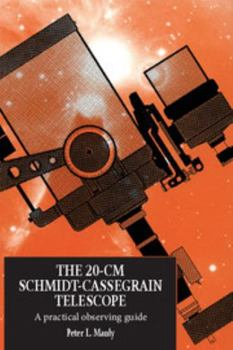The 20-CM Schmidt-Cassegrain Telescope: A Practical Observing Guide
Select Format
Select Condition 
Book Overview
The 20-cm (8-in) Schmidt-Cassegrain telescope is the most popular telescope in the world. This compact instrument revolutionized amateur astronomy and astrophotography, and more than ten thousand are... This description may be from another edition of this product.
Format:Hardcover
Language:English
ISBN:0521433606
ISBN13:9780521433600
Release Date:October 1994
Publisher:Cambridge University Press
Length:283 Pages
Weight:1.35 lbs.
Dimensions:0.8" x 6.3" x 9.3"
Customer Reviews
5 ratings
Excellent user's guide
Published by Thriftbooks.com User , 21 years ago
As the author points out, the first economical 20 cm. S-C telescope by makers such as Celestron and Meade revolutionized amateur astronomy back in the 70's and 80's, and their influence is still being felt today. The telescope's design has many advantages over the competition, such as good portability, excellent control of optical distortions, and ease of use. The S-C telescope is distinguished by having a concave paraboloidal primary with a convex hyperboloidal secondary, compared to the Gregorian telescope with it's similarly paraboloidal primary but concave secondary, which produces an upright image, unlike the S-C which is inverted like most telescopes. The corrector plate on the front of the S-C corrects for spherical aberration.This design is different from the little 3-inch Maksutov scopes from Questar. These use a hyperboloidal primary and secondary. The advantage to this arrangement is that the positive and negative surfaces act to cancel out various optical aberrations and distortions. My understanding is that the Celestron telescopes actually employ elliptical rather than paraboloidal optics, but anyway, tens of thousands of these scopes have proven their worth in the hands of new and experienced amateurs around the world for decades.If you're an experienced amateur, many of the topics, especially on viewing various sky objects will already be familiar to you, but if you're a new amateur there is much good information here. The author starts out with a brief intro and history of the instrument and then proceeds to a discussion of how to get started in viewing using easy subjects such as the moon and planets, and then proceeds to more advanced and harder to locate subjects like nebulae, star clusters, double-stars, galaxies, and so on. For the intermediate and advanced amateur, there are chapters on special topics such as observing variable stars, asteroids, comets, and multiple Jovian eclipses.The last half of the book has sections on some of the more modern accessories and topics aspects such as international networking, astrophotography, photometers, spectroscopy, televisions and image intensifiers. There is an extensive series of appendices on topics such as cleaning the corrector plate, how to align the polar axis, collimation of the S-C telescope, mount vibrations, a field operations packing checklist, astronomical nomenclature, and a list of dozens of the brightest stars and nearby stars. The author's story about how he was the first person, using an amateur group of observers spread out over Arizona, to gather the necessary obsevational data to calculate the size of the asteroid Aglaja during it's occultation of a star, was interesting. And the section on astrophotography reminded me of my first experiences in that area in the early 70's using a 25 or 30-year old Exacta VX Thagee-Oresden camera. Overall this is an excellent user's and observer's guide that should be valuable to new and experienced observers alike.
Good info., style takes some getting used to
Published by Thriftbooks.com User , 24 years ago
There really are some genuine nuggets of wisdom in this book. One has to become accustomed, however, to the first-person narrative and the sometimes "I'm so cute" humor.if you can look past the stylistic concerns, there's a lot here to like.
A good book
Published by Thriftbooks.com User , 24 years ago
This is a very good book; at times humorous, and at times just plain warm-feeling! It deals with many aspects of SCT's , some chapters are a bit too thin for my tastes now. Although I read it cover-to-cover already; I keep going back to it quite often..
great
Published by Thriftbooks.com User , 25 years ago
MY REVEIW IS THAT THIS IS A GREAT BOOK
Good book , Great Reading
Published by Thriftbooks.com User , 26 years ago
I found this book great reading. If you have just bought a SCT or are looking to purchase one, this is highly recommended. Easy to read without all of the Technical Jargon. You can relate to the what the Author is conveying with the practical examples given.






